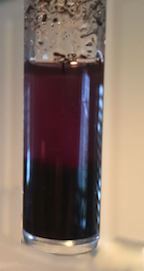Garden Blog
-
Newsletter for Summer 2025
Check out our Summer 2025 newsletter, the 50th Anniversary issue!
We have articles about teaching children about the garden, interviews with garden members, information about food-related legislation, a book review, longstanding garden members’ reflections on the garden at its 50th anniversary, and other garden reminders. We are also reprinting an article on the history of the Nyack Community Garden, originally published in our newsletter in 2018. We hope you enjoy this issue, and happy gardening!

-
Garden Contest winners
Congratulations to all the winners of this year’s Garden Contest.
Our Judges were Mayor Joe Rand and Village Administrator Andy Stewart. Both took the role quite seriously and spent considerable time walking through the garden plots making sure to consider both full and half plots.
As always, we appreciate everyone’s time and attention in helping to make our garden the gem of the Nyack community.
Best Overall
Jayne Stuecklen & David KiremidjianMost Creative
1st Place Nicole & Donna Faustini 2nd Place Marie Carmel Grube 3rd Place Niki StrippoliBest Veggie Garden
1st Place Tom Wondra 2nd Place Aaris Sherin 3rd Place Denise HoganBest Veggie and Flower Garden
1st Place Lynda Grant 2nd Place Donna Hudson 3rd Place Vivienne Von Wiederhold & Alicyn MindelPrizes will be given at our annual potluck dinner so please make sure to put it on your calendar.


-
Newsletter for Fall 2024
Check out our Fall 2024 newsletter, the “Feast” issue. We have great recipes featuring pumpkins, jalapenos, red lentils and a whole slew of interesting articles on what’s growing in the garden!

-
Garden Contest winners
Hello All,
How beautiful our gardens looked for the contest! Thank you all for cleaning up and making us look so neat and lush.
We are delighted to announce the winners of the 2024 Garden Contest!
Best Vegetables:
1st place - Karissa Sullivan - 27B 2nd place - Lauren Pakain - 32 3rd place - Vivienne Von Wiederhaold /Allcyn Mindel - 8BBest Veg/Flowers:
1st place - Nikki Strippoli - 7 2nd place - Olive Crone/Alexandra/Janet Hamlin - 6 3rd Place - Donna Hudson - 18Most Creative:
1st place - Nicole & Donna Faustini - 48 2nd place - Jayne Stuecklen/David Kiremidjian - 36 3rd place - Jill Remaly/Tony Berman - 35Best in Show!
Nicole & Donna Faustini - 48Thank you to Marie Dilluvio for organizing this, and to our judges, Joy Macy, Bluefields Farm, Blauvelt, and Zoie Freidberg from Little Gem Farm, Orange County.
Congratulations to all the winners, and to the very large number of good gardeners and gardens this year.
Thank you,
The Garden Committee
Congrats to all!!

-
Newsletter for September and October 2022
Check out our Summer 2024 newsletter, the “Commmunity” issue. We have a great article on Rona, who was one of our youngest gardeners, and how the garden has helped her family, and the garden as a “great place to learn about community”. We also read about the garden as a “sharing community”, our pollinator gardens, and our contributions to the broader community through Plant-a-Row. Finally we have some very interesting and useful articles about “We Need to Change our Food System and What We Eat”, the “Passion Flower” and “Chamomile”, and “Cultivating Healthy Soil”.

-
Garden Class on seeding and tools
A week or so ago we held a garden class where we planted the Elegance Greens Mix from Johnny’s. This mix is mostly different mustard varieties (Brassica species) that grow fast and like cool weather, perfect for spring and fall. Most of what people call Asian greens are different mustard species, so this mix has those greens, plus a few leafy cabbages. You can sow the seed very densely and then harvest the greens using your scissors, you might get 3-5 harvests from one planting. Eat the flowers as well, they’re delicous.
The key to getting good germination is keeping your soil moist for the first few days and making sure your seeds have good contact with the soil. A good trick is to put a fine layer of some soil mix on top of the garden soil, then make your shallow row, 1/4” say, in that fine soil. Sprinkle the seed in the row, cover with fine soil, and tamp that down. Water each day, unless it’s raining, and you’ll get good germination.
We also talked about hoes. There are many different kinds of hoes, some for digging, some for weeding, some for mixing. We have two kinds of weeding hoes in our shed. One is called a stirrup hoe or shuffle hoe:
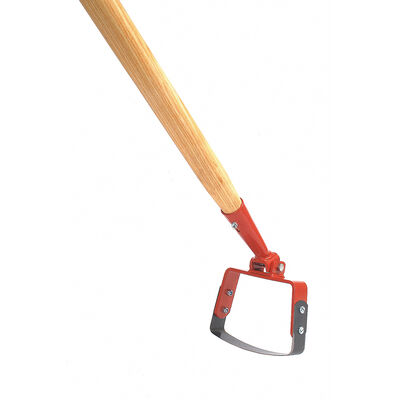
This one cuts the weeds at the soil surface, using a back-and-forth motion, thus shuffle hoe. You can weed an entire plot very quickly with this hoe.
The second one is called a goose neck hoe or half moon hoe:
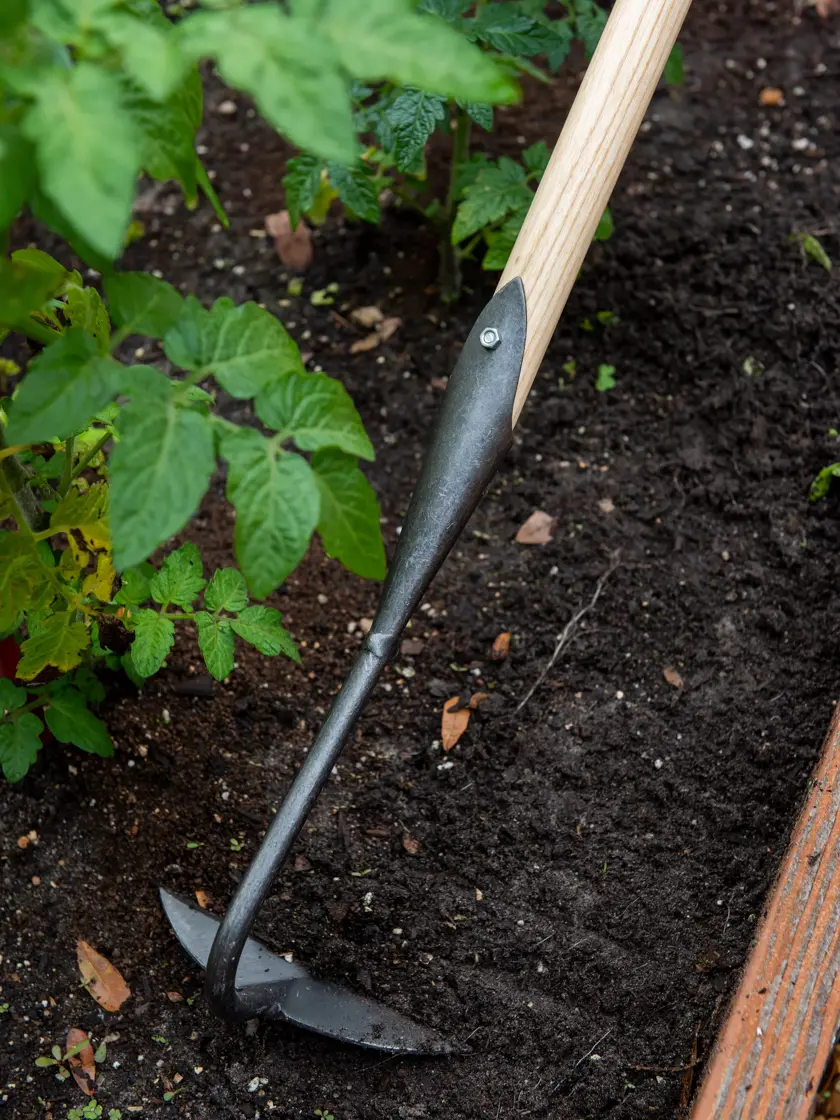
This one is great for fine weeding, like in and around big plants. You cut the weeds at the soil surface by pulling it towards you.
Use the right tool for the job!
Brian O.

-
Avoiding insecticides with a mosquito trap
Here’s an interesting post from the Audobon Society of Virginia that a gardener shared with me:
HOW TO SET UP A MOSQUITO LARVA TRAP
The idea is to get the female mosquito to lay her eggs in a tempting bucket of water that has fermenting hay in it, apparently a very attractive environment for a mosquito. Unfortunately for the mosquito the water is laced with Bacillus thuringiensis (Bt), which kills the larvae when they hatch.
Makes you wonder if similar strategies would work with any of the pests that do the most damage in our garden, which include the flea beetle and the squash borer (and to a lesser extent, the bean beetle and grasshoppers). In fact, there are squash borer traps, but we’ve never tried them out.
Anyone want to buy some and see if they work?
Brian O.

-
Newsletter for Fall 2023
Check out our Fall 2023 newsletter, which is our “Sharing” Issue. There are articles on sharing work and garden plots, sharing the garden with hummingbirds, sharing food through Plant-a-Row, plants sharing the soil through companion planting, and sharing a meal at our annual Potluck dinner.
There are also pictures from the Garden Contest, where this year’s winners were:
Best Vegetable Garden:
1st Place - #14, Aaris Sherin 2nd Place - #9, Stephanie SalterBest Flowers and Vegetables:
1st Place - #38, Gayle Sturmer/Eric Rosenberg 2nd Place – #21B, Liz Cherry/ Michelle MoralesMost Creative:
1st Place - #48, Nicole & Donna Faustini 2nd Place - #36, Jayne Stuecklen/David KiremidjianBest Over All:
#45 & #46, Cristiane Bertone/Glen Holley, Alley Olsen, Nancy Gray/Elizabeth Turk

-
Newsletter for September and October 2022
Check out our September-October 2022 newsletter, it has superb articles: Planting Flowers for Arrangements, an article about Huge Watermelons and cucamelons, Planting a Winter Cover Crop, Watering our Gardens, Plant-a-Row 2022, pictures of this year’s Garden Contest winners, and some notes from our Board about the upcoming Potluck Dinner. Wonderful pictures, and much valuable information!

-
Garden Contest winners
Hello All,
How beautiful our gardens looked for the contest! Thank you all for cleaning up and making us look so neat and lush.
We are delighted to announce the winners of the 2022 Garden Contest!
-
Best Over-All Garden:
-
#48 Nicole and Donna Faustini
-
Best Maintained Garden:
- 1st Place #36 Jayne Stuecklen
- 2nd Place #23 Marie Carmel Grube
-
3rd Place #3 Barbara Berasi-Rosen
-
Best Vegetable and/or Garden:
- 1st Place #43 Nyack Garden Club
- 2nd Place #8B Vivienne Van Wiederhold
-
3rd Place #20 Christine Randolph
-
Most Creative Garden:
- 1st Place #7 Niki Strippoli
- 2nd Place #37 Jill Remaly
- 3rd Place #49B Cristiane Bartone
Congrats to all!!

-
-
Newsletter for July and August 2022
Check out our July-August 2022 newsletter, it has wonderful articles on The Insect Apocalypse, and Birds in the Garden, and some notes from our Board.

-
The Rover radish
I’ve tried a few different radishes over the years, but none better than the Rover radish. This one is an F1 or hybrid radish, which means it’s the progeny of a cross between 2 inbred radish strains. You’ll grow radishes in cool weather, and the best radishes are grown in the fall when the weather is cooling and the days are getting shorter. For example, this year I planted the seed on September 6. Radishes grow quickly, and I harvested the first full size radishes about a month later. What’s nice about the radish is you harvest over a number of weeks, as the smaller ones grow in size. I’m still harvesting radishes in November.
You don’t need to sow the seed in rows. Till a rectangle, say 2 feet by 4 feet, and make the soil as fine as possible so the seeds get good contact with the earth. Remove the big pebbles. Fertilize the soil with some organic mix.
Then sow the seeds right on the surface, and take a rake and gently work the seeds in. Water well, and keep the soil moist over the next 3 days or so, this is essential for good germination. You may have to thin out some of the radishes, but also keep in mind that these don’t mind growing close together. Fertilize frequently with some fertilizer tea, which is a handful of organic fertiizer mixed with water in a watering can that’s left to steep overnight. This is also important, it’s pretty much guaranteed that your soil is not that fertile, here in the Nyack Community Garden (we’ve done a number of soil tests that confirm this).
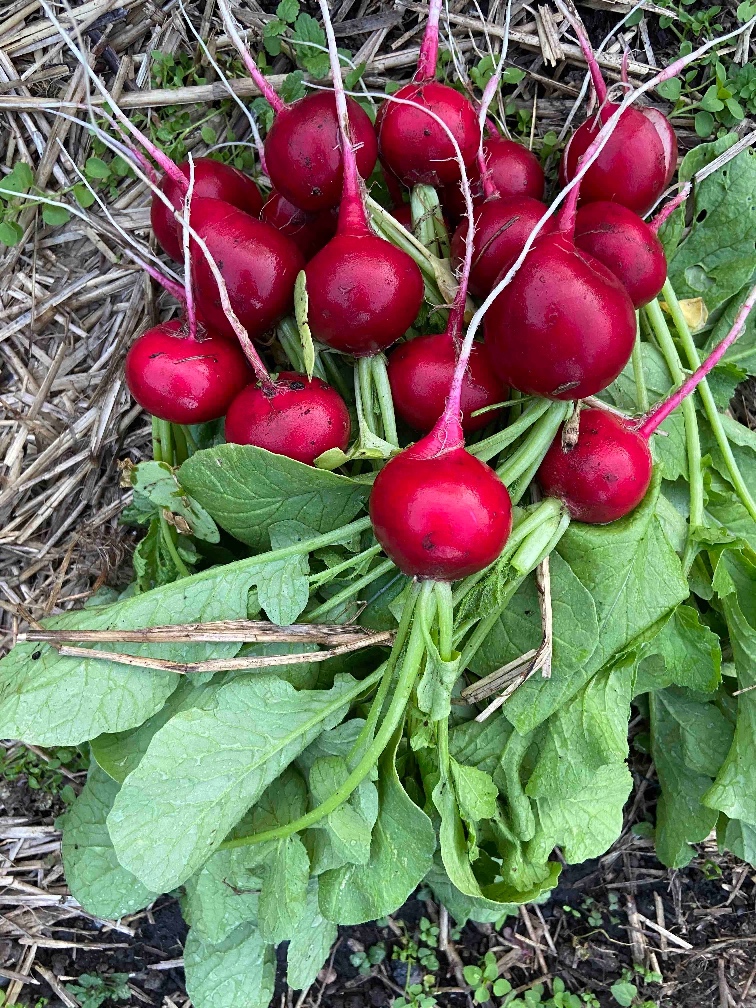
Brian O.

-
Newsletter for Fall 2021
Check out our October-November 2021 newsletter, it has articles on the “Mother of Butterflies/Keeper of Cocoons”, more wonderful Book Reviews, news on Did We Squash the Squash Borer?, a highly successful Plant-a-Row for 2021 Update, and an update on the Garden Contest.

-
Newsletter for July and August 2021
Check out our July-August 2021 newsletter, it has articles on Garden Pests, some Book Reviews, and Introductions of our Executive Board Members.

-
Great Tomato Plants at Nyack Farmer's Market
Dear Gardeners,
Good news! The Nyack Farmer’s Market is back, on Thursdays as usual.
If you need some tomato plants - and growers are selling out their seeds and plants right and left nowadays - check out Greenbush Gardens, they are selling at the Bluefield Farm stall. They have an excellent selection.
I got these plants, they will all do very well in our garden:
- Green Giant
- Sun Gold
- Gold Medal
- Rutgers
- Cherokee Purple
I also got a couple that I’ve never tried before: Chocolate Stripes (looks like Green Zebra, but red and green) and Genuwine, which is a cross of a Brandywine and Costoluto Genovese, an heirloom from Italy that’s known for its flavor.
Other garden favorites include Mortgage Lifter, Black Krim, 4th of July, Paul Robeson, Brandywine, Roma, San Marzano, these are all good choices. Plus peppers, lettuce, cabbage, flowers, herbs ….
Brian O.

-
No more alternate day rule!
Greetings Fellow Gardeners.
We are so happy to send this email with the news that so many of you have asked for: effective immediately, we are revoking the every-other-day rule!!
We are doing so based on the recent CDC recommendation (which has been adapted by NY State) that vaccinated people do not need to wear masks in most situations and with the growing evidence that infections outdoors are rare. So, we are revoking the every-other-day rule and retaining other common sense rules: if you are not vaccinated or are unable to maintain a six-foot distance from your fellow gardeners, wear a mask.
We hope to see all of you during this planting season!
And… One other reminder.. All plots must be fully planted by May 31 or they will be assigned to someone on the wait list.
Nyack Community Garden Executive Board

-
Welcome Back Gardeners!
Welcome back to returning gardeners, and a big welcome to our new gardeners! We look forward to sharing our love of gardening with you and the promising season ahead.
Please see two important documents: plot assignments and committee assignments. Also see the document about NCG going organic. Please read it carefully also.
Important Reminders
- Due to the pandemic, our annual Garden meeting has been canceled, and COVID-related restrictions will remain in effect until further notice.
- Gardeners are only permitted to come in the Garden on their assigned day (see plot assignment document). Plots highlighted in yellow can be attended on even-numbered days of the month; these plots have a red ribbon tied to the fence by their plot numbers. Plots not highlighted can only be attended to on odd-numbered days.
- Gardeners must wear face coverings when in the Garden and maintain at least a 6-foot distance from other gardeners.
It is critical that we adhere to these restrictions again this season in order to guarantee the health and comfort of all gardeners. As with all of our rules and regulations, not adhering to the COVID restrictions during the gardening season will result in a reduction of plot size or loss of membership. Please remember these changes were made to protect our gardeners during these uncertain times.

-
The Nyack Community Garden Goes Organic!
Organic gardening helps to maintain healthy soil by nurturing the life within it. Soil is a living, dynamic ecosystem and not just dirt. Each individual garden plot is connected to all of the other plots in our Garden. Within this linked ecosystem are bacteria and fungi, nematodes, earthworms and insects. Together, they help to break down plant material and convert them to nutrients for your plants. Without them, the soil would be dead and unproductive. And what happens in one Garden plot can affect all of the other plots in the Garden because they are connected by a web of life!
Human-made fertilizers (like the original Miracle Gro), pesticides and herbicides (like Round-up) will destroy the balance of this living ecosystem over time, eventually making all of the Garden plots less productive.
So, when buying a product to use in the Garden, be sure it says “Organic” on the label. Organic solutions to pests, as well as organic fertilizers, are available at every nursery and garden center (and our local hardware store). You can also shop for them online.
It is also helpful to add compost to your soil if you have some. If you don’t have compost, find someone who has a compost pile and will give you some! Compost adds nutrients, moisture, and beneficial bacteria that help to prevent plant diseases. There are tons of articles on the Internet to help you learn more about organic gardening, as well as tons of books! Remember, what happens in one plot affects all of the other plots in the Garden because of the unique webbed structure of the soil environment. Love the soil in your plot, and it will love you back by producing nutritious and delicious food for you!
See The Nyack Community Garden Goes Organic!.

-
Newsletter for October and November 2020
Check out our October-November 2020 newsletter, it has articles on Weeds, Glorious Weeds, Benefits of Community Gardening, and 2020 Garden Photos from Nancy Jagelka.

-
Newsletter for July and August 2020
Check out our July-August 2020 newsletter, it has articles on Plant-a-Row, Nyack’s Pollinator Pathway, Gardener Spotlight: Andrea Joyce, and Black Farming and Institutionalized Racism at the USDA.

-
Great Tomato Plants at Nyack Farmer's Market
Dear Gardeners,
Good news! The Nyack Farmer’s Market is back, on Thursdays as usual.
If you need some tomato plants - and growers are selling out their seeds and plants right and left nowadays - check out Greenbush Gardens, they are selling at the Bluefield Farm stall. They have an excellent selection.
I got these plants, they will all do very well in our garden:
- Green Giant
- Sun Gold
- Gold Medal
- Rutgers
- Cherokee Purple
- Black Krim
Other garden favorites include Mortgage Lifter, Paul Robeson, Brandywine, Roma, San Marzano, these are all good choices. Plus peppers, lettuce, cabbage, flowers, herbs ….
Brian O.

-
Garden COVID Guidelines
Dear Gardeners,
The Garden will open on Saturday, April 18! We are delighted to be able to open the Garden at this time, but we recognize that if we do not adhere to the restrictions mandated by the state, this oasis can be taken away from us at any time. In order to enforce social distancing we are assigning alternating days for gardeners to be in their plots. A schedule is shown below.
People WITH HIGHLIGHTED names may garden on ODD days of the month. These plots and half-plots will have a red ribbon tied to the fence, near the plot number.
People without highlighted names may garden on even days of the month (plots with no ribbon).
Other COVID19 rules:
- Only one person may be in a plot at a time (or two if you live in the same household).
- Maintain at least a six-foot distance between you and other gardeners at all times.
- Wear gloves at all times in the Garden. We also recommend a mask, in compliance with state guidelines.
- Bring your own tools, if you can.
- Disinfect any communal tools that you use, as well as the spigots, hoses, gate and lock. (Yes, spigots and hoses. Water will be on.)
- Do not leave brown compost bags by the shed or gate. If full, bring them to the curb. If not, keep them in your plot.
Finally, non-COVID19 rules and news:
The locks will not be changed, so returning gardeners should retain their keys from last season. New gardeners can pick up their keys from Pickwick Book Store. Please call ahead to be sure Jack is available: 845-358-9126.
Remember, all types of squash, zucchini, watermelon, pumpkins and cucumbers are NOT permitted to be planted in plots this season due to an invasive pest that winters underground and spreads from plant to plant
Once again, we recognize that these rules are restrictive. But the safety of our gardeners is our top concern. If you are not willing to abide by these rules or are uncomfortable being in the Garden at this time, you are welcome to take this season off and return next year. Please let us know as soon as possible if this is the case.
As in previous years, all plots must be planted by May 31.
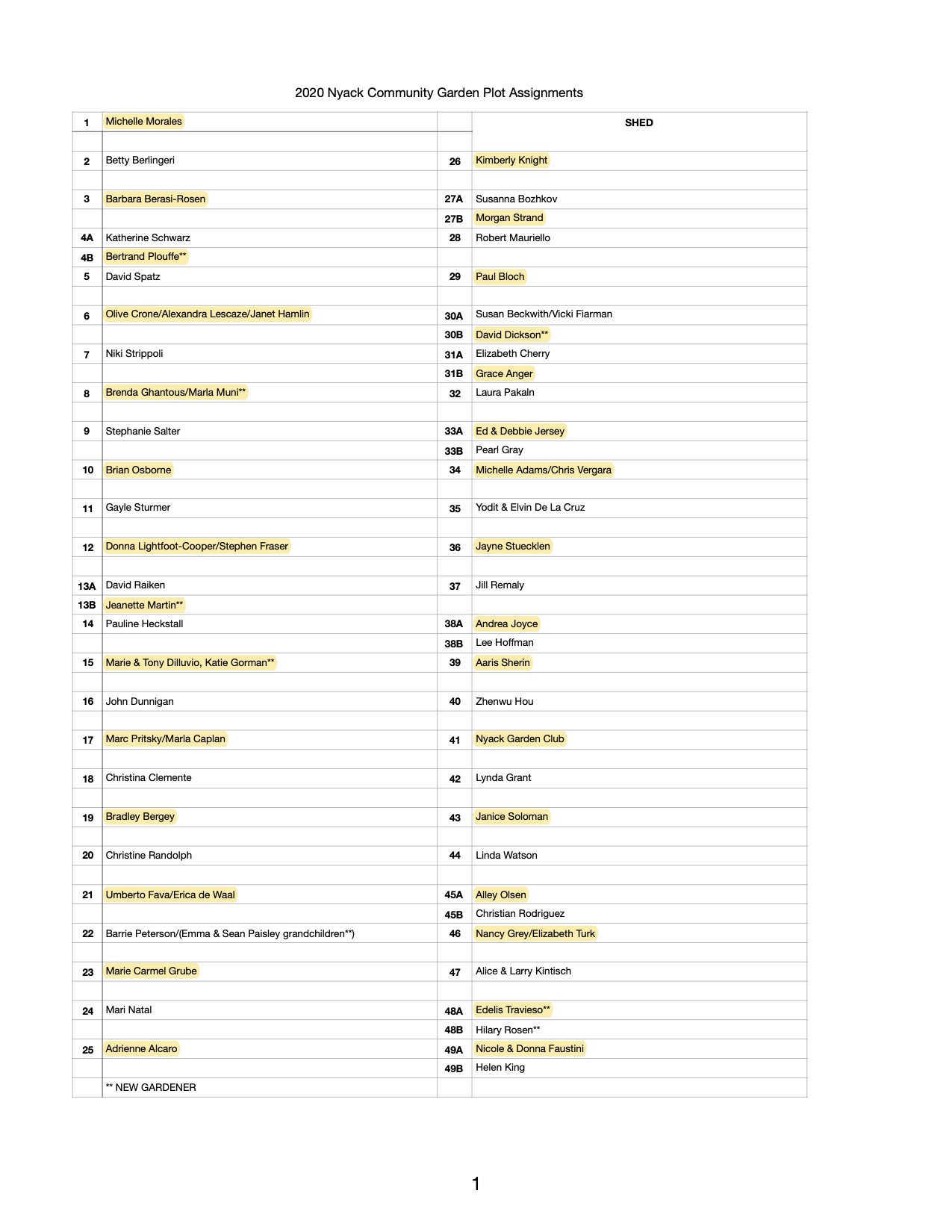

-
About the Squash Borer Rule
Dear Gardeners,
There’s a new rule this year which says:
All types of squash, zucchini, watermelon, pumpkin and cucumber are NOT permitted to be planted in plots due to an invasive pest that spreads from plant to plant.
So, simple rule, don’t plant anything that can harbor the squash borer, but why? First off, read up on this insect, here’s a good page describing it. Check out the life cycle details, and the various methods to protect plants from the borer.
OK, but what about the squash borer in our garden? Strange but true, but there are gardeners who are not aware that the squash borer is well-established in our garden, and it’s been here for as long as many of our long-time gardeners have been here. Every year we’ve observed our plants, waiting for those weeks in late July when the borer damage appears, and the plants collapse and die, usually very quickly, sometimes overnight. In 2019, for example, I planted 2 different varieties of summer squash (2 Pantheon, and 1 Black Beauty) and all 3 plants were killed by the end of July.
Some gardeners will say “But I grew summer squash last year!” That’s right! A handful of plants survive every year, sometimes very weakened, but sometimes doing pretty well. But if you observe our garden every year over the years like we’ve been doing you’d conclude that somewhere around 3 out of 4 plants are killed each year, and the larvae leave the dead plant, burrow down, pupate, and wait in the soil for the warm weather of the following year, when they emerge as adults to mate and lay eggs on the plant stems, year after year.
Back to the treatment methods, and the real world of our garden. Pesticides are out, many gardeners in our garden would absolutely refuse to use them. Plus this would involve spraying all plants in the garden every week for multiple weeks. This won’t happen. What about row covers? I tried this myself a few years ago, it did not work, presumably because the borer was in the soil right where I’d planted. As the article says:
…because squash vine borers spend the winter in the soil near their host plants. When the adults emerge the following summer, they may be trapped under the row cover instead of being kept out.
There are also other methods discussed on other pages online, diatomaceous earth, coffee grounds, wrapping stems in foil, etc. For every one of these methods there’s a person who says “did not work for me”, these methods are partially effective, at best. I tried the diatomaceous earth one season, it did nothing.
What is the most effective method, without using pesticides? From the article:
Practice rotation to minimize this issue by planting cucurbits in different areas of your garden (if possible) or alternate seasons when you grow cucurbits.
Here’s the same advice, from Managing Squash Vine Borers in New Hampshire:
Rotation can help reduce problems with this pest. Moving cucurbits to different fields year-to-year can reduce problems, especially if the fields are far apart. In a backyard situation, the space is so small, moving the crop a few feet doesn’t help prevent damage next year. One option is to skip a year: don’t grow any (susceptible types of ) squash or pumpkins next year if you had significant damage this year. If your neighbor grows them just a few feet away, that defeats the purpose of this technique.
This method works, this is what an organic farmer would do. For example, they might have 2 separate fields, and plant summer squash in one of them in alternate years.
So what will happen in our garden this year because of this new rule is that the borer adults will emerge in late spring, they will look for squash plants or other cucurbits, they won’t find any plants to lay eggs on, there will be no larva growing, and no larva overwintering. Then next year, in 2021, there will be no squash borers in our garden, and everyone will be able to grow fantastic summer squash, for the first time in many years.
Brian O.

-
2020 Garden applications
Dear Gardener,
I’m looking forward to gardening at the Nyack Community Garden this year, and I hope you are, too.
The Executive Committee asked me to send you application materials for the Nyack Community Garden’s 2020 season. This email is a notification that the application forms will be emailed to you within the next day or two.
If you are not interested in continuing as a Nyack Community Garden member, please let me know by return email so that you will not be sent the application materials.
If you wish to continue as a member of the Nyack Community Garden and do not receive the email with application files within the next day or two, please check that emails with attachments from nyackcommunitygarden@gmail.com are not treated in as spam in your email system. Let me know if the files need to be emailed to you again or if you need a copy sent by postal mail. If you are unable to print the application files, also let me know and I’ll mail a paper copy to you.
Your application for the 2020 season must be on the 2020 forms. The completed signed application form, signed acceptance of the 2020 Rules and Regulations, and a check for your plot must be sent to the Garden postmarked no later than Saturday, Feb. 22, 2020. The materials should be mailed to Nyack Community Garden, PO Box 864, Nyack, NY 10960. Additional instructions are on the forms.
For future reference, we ask that you please keep a copy of the Nyack Community Garden Calendar, a copy of your completed application, and a copy of the 2020 Rules and Regulations.
I encourage you to invite your friends who reside in the Nyack School District and are interested in gardening at the Nyack Community Garden to email nyackcommunitygarden@gmail.com to request the new member application forms.
For additional information, please go to our website at nyackcommunitygarden.info or email us at nyackcommunitygarden@gmail.com.
Alice Kintisch
Nyack Community Garden Email Manager

-
Newsletter for October and November 2019
Check out our October-November 2019 newsletter, it has articles on Monarch butterflies, Seed saving, and Nyack pollinators.

-
Garden Contest Winners 2019
And the winners are:
Best overall: Jill Remaly - 37
Best maintained:
1st Elvin & Yodit de la Cruz - 35 2nd Linda Watson - 44 3rd Pritsky/Caplan - 17Best vegetable and flowers:
1st Jayne Stuecklen - 36 2nd Janice Solomon - 43 3rd Morgan Strand - 27Most creative:
1st Marie Carmel Grube - 23 2nd Fava/De Waal - 21 3rd Mari - 24Congrats to all!
And there are so many beautiful, creative and well-maintained gardens in addition to these.

-
Newsletter for July 2019
Check out our July-August 2019 newsletter, it has articles on Types of Seeds, Seed Extinction, Plant-a-Row, and Nyack Community Garden Joinimg the Climate Victory Gardening Program.

-
Buy Tomatoes and Peppers at The Grow Room
I know that Nyack gardeners like to buy plants locally, and I’ve learned that Lindsey at The Grow Room on Bridge Street in the center of Nyack is growing tomatoes and pepper plants that we can buy in May. She told me that she’ll have these varieties:
Tomatoes
- Green Giant
- Sun Gold
- Purple Cherokee
- Amish Paste
- Brandywine
- Gold Medal
- Solar Flare
- Rutgers
- Fourth of July
- Sweetie
- Green Zebra
Peppers
- Shishito
- Jimmy Nardello
- Fish Pepper
- Trottolino Amoroso
- Garden Sunshine
- Lemon Spice Jalapeno
Many of these varieties do very well in our garden, just thought you would like to know. You can call The Grow Room at (845) 348-8811.
Brian O.

-
Interview with Wilsie Reese
Interview with Wilsie Reese
Wilsie Reese has been gardening in the Nyack Community Garden longer than almost anyone else. She couldn’t remember exactly what year she started, but she estimated it was around 1993. She was living on Byrd Street at the time and the president of the garden at the time, Mrs. Porter, noticed what lovely flowers she had planted around her house and suggested she join the Community Garden, so she did. (At that time, she remembers John Dunnigan and his mother being involved, too.) There was already a big fenced in space at that time and maybe around 40 gardeners altogether. The water supply was there, but no shed and no bench and no fencing around Nyack Brook, just to the east of the garden.
Wilsie remembers that everyone had the equivalent of a full plot; there were no 1⁄2 plots then, and everyone would start digging in the garden and come across railroad stakes all the time. (The garden is situated on top of what used to be the last stop of the Erie Railroad line.) And lots of rocks! (Somehow rocks grow better than anything else – is this only in Rockland County?). Because there was no fence around Nyack Brook, they would throw all the rocks into the brook.
Back then, you could grow sunflowers and corn, and many did – until they recognized that these plants did so well they would start shading other people’s veggies, so they devised the rule prohibiting us from choosing those plants to propagate. Wilsie herself started by growing what she considered to be the essentials - tomatoes, green beans and kale – and always some flowers. She has been growing those essentials ever since, although she has branched out and tried some other veggies over the years. Mostly she planted from seed; only her tomatoes, she would purchase the starter plants, and her youngest son would help her, especially with the weeding, and still does to this day. She was the proud winner of 2nd prize in one of the contests one of the years.
She told a couple of lovely stories of her experiences in the garden. She was still laughing at the memory of her son helping her harvest in the garden when he was about 15. He had come across the pepper plant that had beautiful, colorful, peppers beaconing to him. Before she could warn him, he popped one into his mouth and was totally shocked – it was an extra hot variety!
Another harvest that was a complete surprise and a complete joy all around was three years ago when, after always shying away from planting watermelons for so many years, she decided to try planting them. She bought 2 plants, and then someone else in the garden offered her 2 more plants. She made space for all 4, mounded them up, and lo and behold, they started growing well, maybe too well, because she had to clip some of the vines to keep them from overwhelming her neighbors’ plots and from growing right through the fence. But they yielded 4 absolutely perfect watermelons, which she shared with her daughter.
Her love of gardening began when she was a child (she is now 75) in central Virginia. Her father was the gardener of the vegetables and her mother tended the flowers, which she taught to Wilsie. They had peach and apple trees growing all around and Wilsie came to appreciate gardening and the connection to trees and nature. She moved to Rockland County in 1962 and always loved the hills and trees of this area. She always feels joy and relief when, after a trip into the City, she drives back over the bridge into the green hills of Rockland County. But to this day she cries when she sees a tree being chopped down.
This year, she says, wasn’t the best the in the garden. Because of the heat, but also because her son didn’t have time to help her too much and because she had lost a couple of dear friends this year. But she still loves the gardening. And she especially appreciates the addition of the bench. Now she can go in, tend to her garden and then go sit on the bench for a while, take in the whole ambiance, and rest a bit before going back to pulling the weeds. She loves how the community garden has always been a real community – people helping one another, sharing tips, sharing seeds, sharing what they harvest, sharing their enthusiasm and taking pride in what is growing.
Does she have any tips for new gardeners? “When you grow some of it yourself, you appreciate that farming is actually a lot of hard work, and it makes you think differently about the food you buy in the market and the farmer’s hard work that went into providing it for you.” But if you want to start gardening, “Enjoy it! Plant from seeds. Watch your seeds to see it all grow. It’s always good to be there – to get out there and feel the earth. You haven’t tasted a tomato until you have picked it and eaten it then and there, right off the vine. And the fresh green beans, you’ve gotta taste one of those!”
Kathy Schwarz
This article is taken from the Newsletter October-November 2018

-
History of the Property
History of the Property Before the Nyack Community Garden
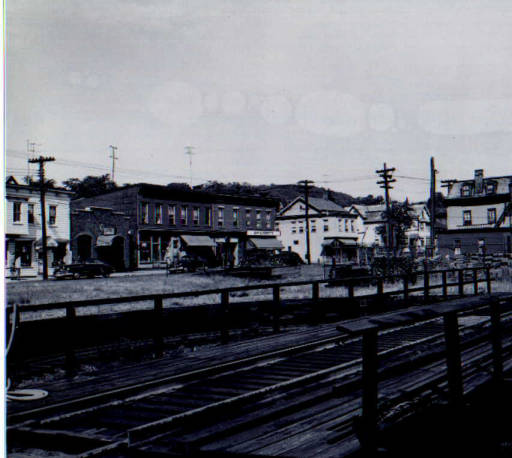
1947 photograph of the tracks and turntable. Collection of Nyack Public Library.
Let us go back to the history of the property before our garden. The land was part of the end-of-the-line complex of the spur of the Northern Railroad of New Jersey, which in 1870 linked Nyack with Piermont and the rest of the line. This line later became part of the extensive Erie Railroad network. An 1876 map indicates that the train tracks terminated at a depot located at the southeast corner of Depew and Franklin Avenue and that further south near an unnamed street on the map (Hudson Avenue) was a freight house. This is our garden’s location today.
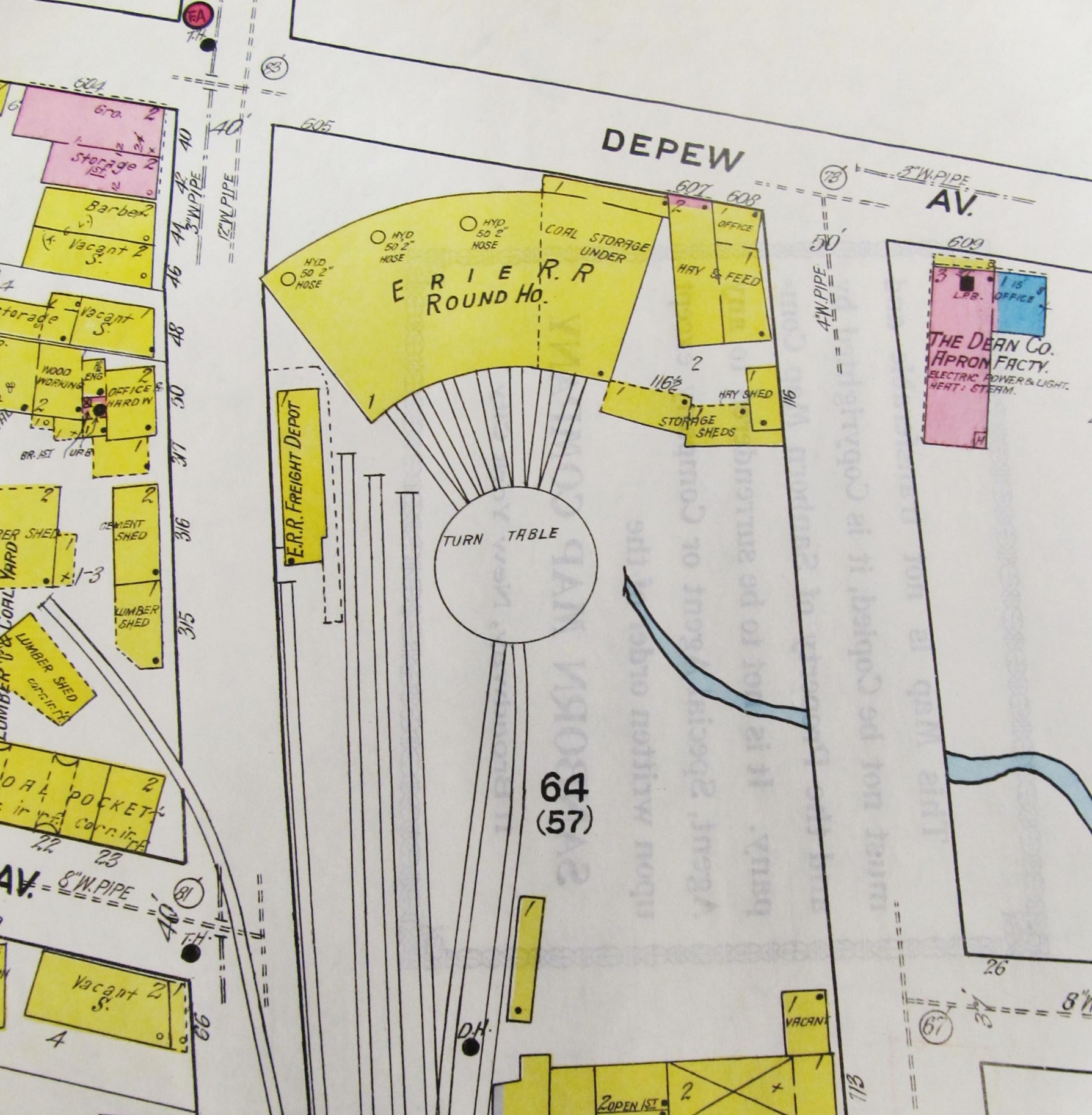
1919 map showing future site of Garden with tracks, freight station, turntable, roundhouse and other end-of-the-line railroad facilities.
There were numerous reconfigurations of the railroad facilities on the site to serve evolving rail functions spanning 95 years. In the late 1880’s, after a new passenger station opened about 2 blocks south at a site which is now Franklin Street Park in South Nyack, the garden’s site continued to have the freight station and other end-of-the line facilities. By 1891 it had a turntable for turning locomotives. In 1904-05 a new round house (actually an arched segment rather than a full circle) was constructed. It was capable of holding seven engines. This structure is shown on an August 1919 Sanborn Insurance Map with seven sets of tracks leading into it from the turntable. The opening of the New York State Thruway and the Tappan Zee Bridge in 1955 lead to the demise of rail service to Nyack. The last train ran in December 1965.

Engine on the turntable. Photograph by Vincent Lee, probably from early 1960’s.
For those of us who want to know more about this railroad history, the time is now. Soon a new historical sign will be added at the property as part of a project to put up 11 signs along the former railroad bed (rail-trail) with information about the railroad between the Nyack Community Garden site and the Piermont Railroad depot building. Andrew Goodwillie will give an “armchair walking tour” about the research that went into creating the historical information signage along the rail-trail. Presented on Thursday, October 25th at 7pm at the Nyack Library and again on Friday, October 26th at 2pm at the Valley Cottage Library. Registration required, http://nyacklibrary.evanced.info/signup/Calendar and http://www.vclib.org/, events calendar. The Historical Society of the Nyacks will host a related exhibit “Tales from the Trail” about the impact of this railroad at its museum in DePew House, lower level Piermont Avenue, on view on Saturdays from 1-4 pm between from October 12 to November 24, 2018.
Robin Brown
This article is taken from the Newsletter October-November 2018

-
History of the Garden
The Nyack Community Garden’s History
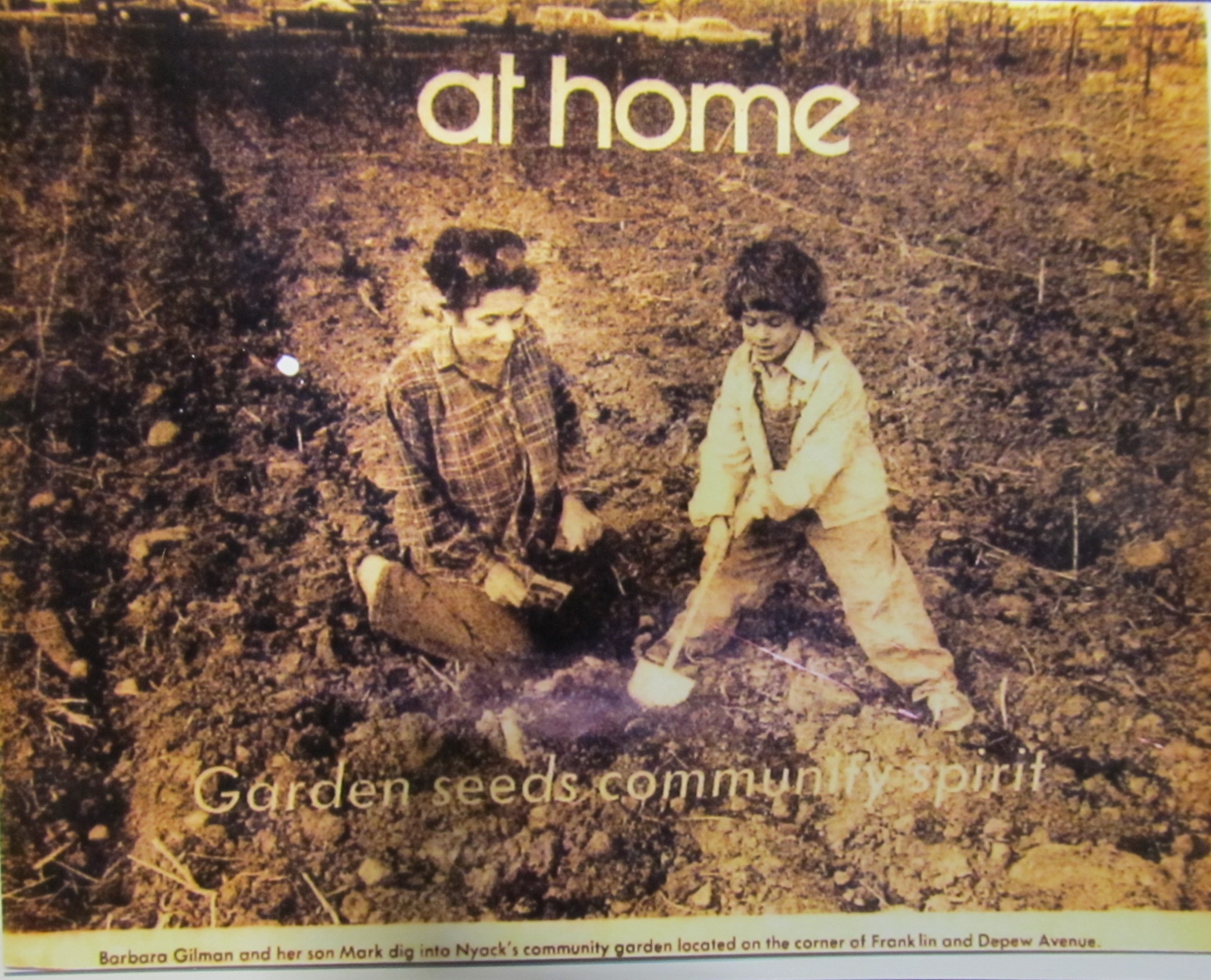
Founder Barbara Gilman and her son in the Garden. Newspaper clipping from Journal News, Collection of Nyack Public Library.
The Nyack Community Garden is very much a part of the national community garden movement in the 1970’s described in our July-August 2018 newsletter. Around 1974-75 the land along Franklin Street between Depew and Hudson was vacant and considered undevelopable. Local people lead by Barbara Gilman and including Dan Rogers and Farrell Freeman, who worked on the effort as part of his Cooperative Extension Master Gardener volunteer commitment, pushed for a community garden on the site.
In addition to the typical benefits to the community of a garden, the Nyack one was also viewed as a means of promoting community within Nyack’s diverse community and as a complement to the adjacent housing being constructed by the Robert Martin Company. The Robert Martin Company agreed and offered the space for a community garden beginning the long and productive sponsorship of the Nyack Community Garden by the real estate investment, development and management firm. It is not exactly clear when the first plot was planted at our garden.
1976 may be the date as Barbara Gilman in 1994 thought the photograph of her breaking ground was taken that year. The Nyack Library has a newspaper clipping with a photograph of garden with the date 1979. 1979 seems to be the year when the garden was fully functioning community garden. The process to turn the overgrown vacant lot full of coal dust, cinders, and other remnants of its past railroad facility into the splendid community resource has spanned more than 40 years.
Initially the overgrown vacant lot, with a good crop of bamboo, did not have very many gardeners and plots were located at the north section. Gradually through outreach to the community the number of gardeners increased and the quality of the gardening experience improved. The garden received a boost in 1979 when Grand Union, who was building a store at the Hub shopping center, donated soil from their excavation. This probably was the beginning of the soil improvement that continues to the present when every 4 to 5 years compost is spread on the garden.
Plots at the time were 10’ x 10’ and the fee $3. Groups involved with the garden included Rockland County Cooperative Extension Service, Nyack High School Interact Club, Rockland Community Action Corporation, and Nyack Rotary. Problems included vandalism of hoses and theft of vegetables. In 1978-79 the Boy Scouts had a plot and in 1980, three and four year-old children at Nyack Head Start had three plots. In the early 1980’s Cooperative Extension’s Master Gardeners visited the garden regularly to answer questions and give tips.
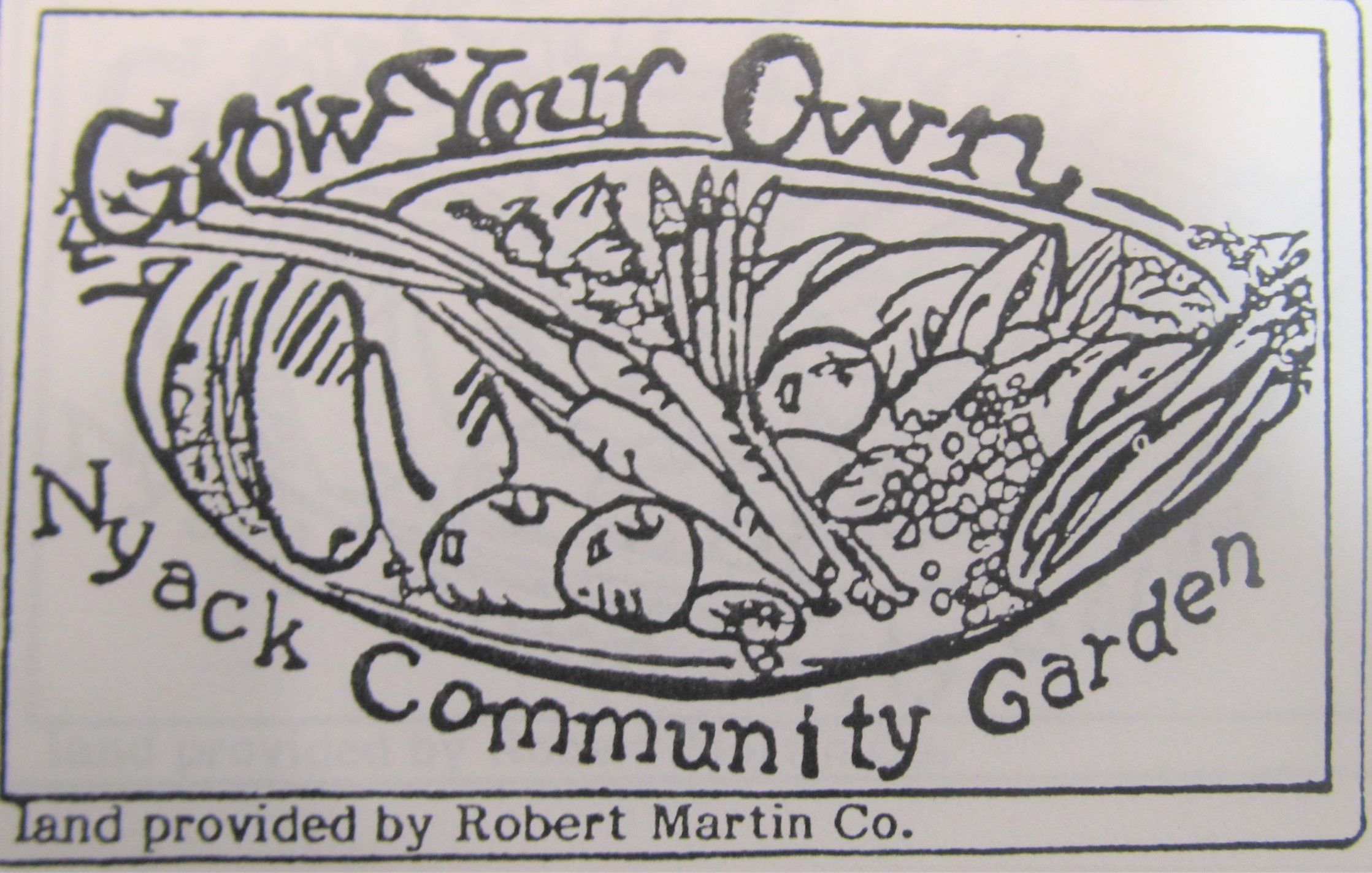
Our mid-1980’s logo. In 1986 gardeners could purchase a T-shirt with this logo on it.
In the early years the garden was enclosed by a snow fence. In 1983, in 1994 and again in 2000, the gardening community successfully advocated that the property not be developed for other uses. In 1985, the garden had its own “Grow Your Own” logo. In the mid-1980s, the garden contest began. Early categories included largest vegetables and most variety of vegetables in addition to most categories that we have today. Some years the contest was not held.
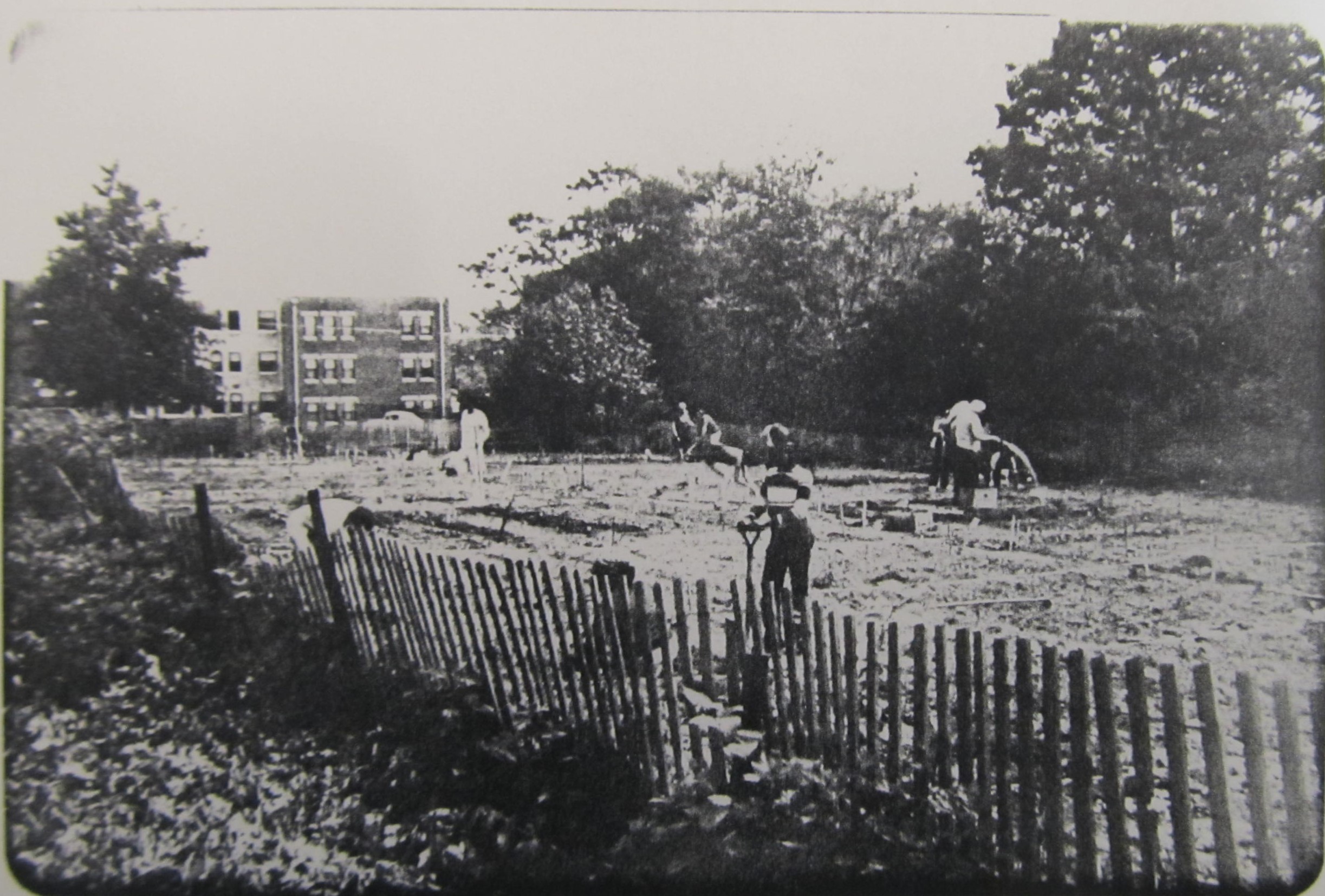
Early photograph of Garden when surrounded by snow fence. Probably taken around 1980. Collection of Nyack Public Library.
By early 1990’s the garden had the general layout that it has today. Annual plot fees were $10 for a full plot and $5 for a half plot. The garden welcomed a lot of improvements in the 1990’s. In 1989/90 Robert Martin Company put up a chained link fence, which was later replaced by a higher one. The following year the gates were locked to prevent theft and vandalism. Rules at the time included must plant by and must clear plots by dates, control weeds on the path, turn off faucet, no sunflowers or dogs, keep gates closed. Until 1992/3 the Nyack Recreation provided administrative support, mowed the grass, and rototilled. Since then the garden members have handled paperwork and other activities. Over the years the Garden has received support from many businesses and civic organizations in Nyack.
Fortunately, Robert Martin Company, in concert with the Community Housing Management Corporation, continues as our best friend, allowing us to use the land, has the surrounding grass mowed, and provides much other generous support. In 1993-94, Robert Martin Company arranged to have water brought directly to the garden. Previously obtaining water was cumbersome. First, water was transported in buckets, then a hose was run across Franklin Avenue, and then a hose was run over the creek to a spigot outside the Nyack Plaza apartments. In 1994 the Garden hosted ARC workers with disabilities in a community work program.
As early as 1993, gardeners made donations of vegetables to local soup kitchens. Our more formal participation in the Plant a Row for the Hungry began around 6 years ago. Around 1995, our first newsletter was published. In the mid 1990’s an annual rummage sale to raise funds coincided with Nyack Street Fairs. In 1996, a new waterline was installed, and our current walk-in shed, so beautifully painted this summer, was erected. In 1998, the garden had 62 members in 35 full plots and 24 half plots. Today, we have 87 members in 68 plots (30 full and 38 half plots).
Improvements and new programs were added in the 2000’s. In 2009, the central walk was handsomely paved. Our website manager Brian Osborne published our first website in April 2010. The colorful sign in the central Franklin flower garden dates to 1912?. In 2016 we added the wooden bench near the shed. In 2017, the flower garden at the corner of Hudson and Franklin became an official Monarch Butterfly Waystation.
Since we have always been a volunteer group, the garden’s success is credited to all its members. Special mention has already been given to the key founders. Other standout people are Ward Feirer, chairperson from 1981-92, assisted by secretary/treasurer Edna Matthews. In 1991, Christine Adams was chair, and in 1993-4 Angela Mathews was chair. From 1994- 2013, Sallie Mae Porter, Bill Weisgerber, and Zsolt Takacs were our chairs. Since 2014, John Dunnigan and Lynda Grant are our co-chairs.
Information for this article is primarily from the Local History Room in the Nyack Public Library. Many thanks to Carolyn Kent and Mary Ann Goddard, members in the late 1970’s, John Dunnigan, Marie Dilluvio, Pauline Heckstall, Dianne Macpherson, Brian Osborne, and Jennifer Rothschild of the Historical Society of the Nyacks for help and recollections.

Chairperson Sallie Mae Porter at the garden in 2000 after leading a successful effort to preserve the Garden. Journal News, April 15, 2000. After Sallie died in 2002, we had a memorial Sallie’s Garden.
If you have memories or facts about our garden that you want to share, please send your comments to nyackcommunitygarden@gmail.com for inclusion in future newsletters.
Robin Brown
This article is taken from the Newsletter October-November 2018

-
2019 Garden applications
Dear Gardener,
I’m looking forward to gardening at the Nyack Community Garden this year, and I hope you are, too.
The Executive Committee asked me to send you application materials for the Nyack Community Garden’s 2019 season. This email is a notification that the application forms will be emailed to you within the next day or two.
If you are not interested in continuing as a Nyack Community Garden member, please let me know by return email so that you will not be sent the application materials.
If you wish to continue as a member of the Nyack Community Garden and do not receive the email with application files within the next day or two, please check that emails with attachments from nyackcommunitygarden@gmail.com are not treated in as spam in your email system. Let me know if the files need to be emailed to you again or if you need a copy sent by postal mail. If you are unable to print the application files, also let me know and I’ll mail a paper copy to you.
Your application for the 2019 season must be on the 2019 forms. The completed signed application form, signed acceptance of the 2019 Rules and Regulations, and a check for your plot must be sent to the Garden postmarked no later than Saturday, Feb. 23, 2019. The materials should be mailed to Nyack Community Garden, PO Box 864, Nyack, NY 10960. Additional instructions are on the forms.
For future reference, we ask that you please keep a copy Nyack Community Garden Calendar, a copy of your completed application, and a copy of the 2019 Rules and Regulations.
I encourage you to invite your friends who reside in the Nyack School District and are interested in gardening at the Nyack Community Garden to email nyackcommunitygarden@gmail.com to request the new member application forms.
For additional information, please go to our website at nyackcommunitygarden.info or email us at nyackcommunitygarden@gmail.com.
Alice Kintisch Nyack Community Garden Email Manager

-
History of the garden
All,
If you have not looked at the October/November 2018 newsletter make sure to do so, it has a great article by Robin Brown on the history of our community garden, plus a wonderful interview with Wilsie Reese, plot 27A (written by Kathy Schwarz), who has been a gardener in the Nyack Community Garden for about 25 years and is a former garden president! Good articles by Kathy, Liz Cherry, and Renae Leeming too, about our garden this year, check it out!
Brian O.

-
And the Winners Are ...
Best Overall Garden: Umberto Fava and Erica de Waal #21
Best Maintained Garden:
- 1st Place - Linda Watson #44
- 2nd Place - Ellen Miret #48A
- 3rd Place - Winnie Muller & Henrik Peterson #19A
Best Vegetable and/or Flower Garden
- 1st Place - Jill Remaly #37
- 2nd Place Renae Leeming #48B
- 3rd Place - Marie Carmel Grube #19B
Most Creative Garden
- 1st Place - Marie * #24
- 2nd Place - Jayne Stuecklen #36
- 3rd Place - Barbara Berasi-Rosen #3
As usual the Judges had a hard time picking winners. A “best cluster” was not chosen.
Marie Dilluvio, Chairman of the Garden Contest Committee

-
Some good varieties
All,
A few people have asked me for a listing of different vegetable varieties that I plant, so here we go. I’ll keep it focused on spring-time vegetables, or vegetables that you plant in springtime for summer harvest. For some vegetables, like lettuce and beets, the listing comes from many years of trying different varieties. For some other vegetables it just happens that I stumbled on a variety that I liked, so I stick with that variety.
Here’s the important piece of advice though: try different varieties, and always keep some kind of notebook. Most people will not be able to remember all the different varieties they try over the years, so keep track of what you do and what you plant in your notebook or spreadsheet (variety, time planted, how you fertilized, any notes on how it did, and so on).
Lettuce
- Skyphos. Dramatic dark red, vigorous.
- Nancy. Boston-type butterhead, pure green.
- Pirat. Butterhead. Not as large as some of these others, but nice texture, with beautiful spotted leaves.
- Forellenschluss. Beautiful spotted leaves, good growth.
- Bronze Arrowhead. Best of the best. Vigorous, green, red, and brown, with a delicate texture.
- Gulley’s Favorite. Butterhead. Excellent texture, green and red.
- Reine des Glaces. Crispy, pure green.
- Grandma Hadley’s. Red and green, looser head.
- Red Velvet. Looseleaf, very vigorous, dark red.
- May Queen. Light green butterhead. Perfect.
Beet
- Merlin. The problem with many heirloom beet varieties is the lack of uniformity. This one is a hybrid, not an heirloom, and it is uniform, tender, and medium sized. Excellent, earthy flavor.
Onion
- Walla Walla Sweet. Big mild onions. Do not forget to fertilize!
Spinach
- Winter Bloomsdale. Good texture, good growth. Have to admit though, I have not tried many different spinach varieties.
Turnip
- Hakurei. Called a turnip, but eaten like a radish, raw. Pure white, delicate flavor.
Arugula
- Apollo. The largest-leafed and least bitter of all the arugula varieties I’ve tried.
Chard
- Silverado. Lovely green and white plant, good texture. Why are you growing kale?
Brian O.

-
Butterflies in the garden
All,
You may have noticed that Monarch butterflies pass through the garden in early to mid-October.
They particularly love the Zinnia’s and the Tithonia’s, which is also known as the Mexican Sunflower.
This video is from October 2017.
Brian O.

-
Accepting applications for 2018
Dear 2017 Gardener,
I’m already looking forward to gardening at the Nyack Community Garden this year and hope you are, too.
Applications for the 2018 season are available now, please contact nyackcommunitygarden@gmail.com for more information.
If you wish to continue as a member of the Nyack Community Garden and do not receive the email with application files this coming weekend, please check that emails with attachments from nyackcommunitygarden@gmail.com are not treated in your inbox as spam. This might be accomplished by adding our email address to your address book. Let me know if the files need to be emailed to you again or if you need a copy sent by postal mail. If you are unable to print the application files, please let me know and a paper copy will be mailed to you.
Your application for the 2018 season must be on the 2018 forms. The completed application with 1) completed and signed application, 2) signed acceptance of the 2018 Rules & Regulations, and 3) check for plot must be postmarked no later than Friday, Feb. 23, 2018. Mail the application materials to Nyack Community Garden, PO Box 864, Nyack, NY 10960. Additional instructions are on the forms.
For future reference, please keep a copy Nyack Community Garden calendar and a copy of your completed application, especially the 2018 Rules & Regulations.
I encourage you to invite your friends who reside in the Nyack School District and are interested in gardening at the Nyack Community Garden to email nyackcommunitygarden@gmail.com to request application information for new members.
Best,
Robin

-
2017 Fall Newsletter
Gardeners,
Here is our fall newsletter, with news about our tent at the Nyack Get Together, the results from the Garden contest, the upcoming PotLuck Dinner, and the Butterfly garden at the south end of the garden:
Newsletter September-October 2017
Thank you, Newsletter Committee!

-
2017 Garden Contest Winners
Best Overall Garden
Plot 36 Jayne Stuecklen
Best Maintained Garden
- 1st – Plot 3 Barbara Berasi-Rosen
- 2nd - Plot 48A Ellen Miret
- 3rd – Plot 30 Dorothy Durkin
Best Vegetable/or Flower Garden
- 1st – Plot 32 Lauren Pakaln
- 2nd – Plot 42 Lynda Grant
- 3rd - Plot 14 Pauline Heckstall
Most Creative Garden
- 1st – Plot 24 Mari *
- 2nd – Plot 37 Jill Remaly
- 3rd – Plot 21 Umberto Fava & Erica de Waal
Best Cluster
Cluster #4, Plots 26-33B, Laura Pakaln, cluster leader, Kimberly Knight, Wilsie Reese, Garden Club of the Nyacks (Elizabeth Turk, Carol Marsh, Sharon Guadagno & Elizabeth Gaeta), Robert Mauriello, Paul Bloch, Dorothy Durkin, Elizabeth Cherry, Mark Schneider, and Kristin Flood
Congratulations to you all! The judges had a very difficult time because every plot was great.
Marie Dilluvio, Chairman of the Garden Contest Committee

-
2017 Plot List and Newsletter
Gardeners,
Here is the plot and cluster list for 2017:
And here is our spring newsletter, with very useful information on mulch:
Finally, we have written an article with advice for new gardeners, check this out:

-
Topsoil added to the Garden
Enhanced Soil Is Ready for Opening Day
A few weeks ago the planting area of the Nyack Community Garden was covered by screened organically-enriched topsoil. Then the area was rototilled so that the soil is ready for early spring plantings when the Garden’s opening on April 9. This addition of “new” rich soil is done every 4 to 5 years to keep the soil fertile. The Garden is typically rototilled annually.
Robin

-
Nyack Seed Exchange
Hi all,
The Seed Exchange at the Nyack Public Library is open for business starting Saturday March 4, and every Saturday from 10-2. We have tons of great seeds that would be very happy in the Community Garden.
Thank you.
Jill
For more information see Nyack Seed Exchange.

-
Save My Soil!
So I’ve been noticing my garden get a little tired over the past couple of years, and I can see my neighbor’s tomato and pepper plants, in particular, looking bigger and stronger. It also seemed to me that all kinds of plants were doing better for me in past years, like onions, cabbage, and garlic. So, time for some analysis. Is it possible that I’ve been losing soil fertility?
As you know, soil fertility is expressed as the amounts of the elements nitrogen, phosphorus, and potassium (NPK). Plus, the pH of the soil has to be right, and if it’s not then the availability of these elements to the plant is reduced. You can send your soil to be tested for fertility (see Our garden soil and And more on our garden soil for results from the Cornell soil lab), or you can do it yourself. So this time, for fun, I got a hold of the LaMotte Garden Kit to do it myself. Pretty easy to do.
I have to say, I was surprised, but not in a good way. But let’s start with the good news:
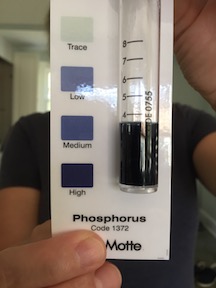
Plenty of phosphorus, just like in the Cornell results from a few years back. But look at this:
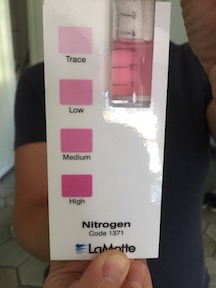
Ack! Somewhere between “Trace” and “Low”, which is dismal for a vegetable garden, where most of your plants are pretty demanding, with respect to N.
And here was the second surprise:
pH 8.0? Last time I checked we were at 7, i.e. neutral, and you want to be somewhere between 6 and 7 (a little acidity does not bother vegetables).
The potassium (K) test is not exactly colorimetric, it’s more like a titration, and you count the number of drops required to get to a certain color. The result there was Low, in K.
So how have I gotten myself into this situation? How come my neighbors seem to have more fertile soil than me, even when I routinely add organic fertilizers when I plant? Well, just not enough it seems. Unlike most of my neighbors, I start early, and stay late, so I’ve got a spring crop of lettuce filling my plot (plus arugula or radishes or cabbage or …), then I start lettuce (plus …) in mid-August, that grows until late October. Would you like to guess what vegetable takes the most out of your soil? That’s right, the leafy vegetables like lettuce have the biggest appetite for N.
Next up, in another post, we’ll talk about fertilizer and how I’ll try to fix all of this.
Brian O.

-
Accepting applications for 2017
Dear 2016 Gardener,
I’m already looking forward to gardening at the Nyack Community Garden this year and hope you are, too.
Applications for the 2017 season are available now, please contact nyackcommunitygarden@gmail.com for more information.
Plots in the Nyack Community Garden are limited. Some returning gardeners, especially new gardeners in 2016, will be awarded half plots rather than full plots even when full plots are requested. 2016 gardeners who did not fully plant, adequately maintain their plots, or fulfill their committee work responsibilities may be awarded a ½ plot rather than a full plot, or be wait-listed.
Best,
Robin

-
A Bench in the Garden
Dear Gardeners,
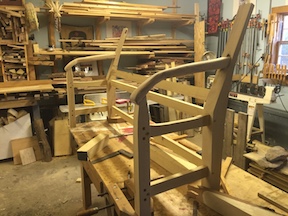
There is a wonderful new addition to our garden – a handmade wooden bench located near the tool shed. It is a place for tired gardeners to rest and for gardeners to sit and enjoy conversations with friends. All gardeners are encouraged to use and enjoy it.
Requests by gardeners for someplace to sit and inspired by the beautiful bench that new gardener Greer Griffin installed in plot 13, Marie Dilluvio, with the approval of fellow Executive Committee members, arranged to have our custom-made bench made. The skilled craftsperson who made it is Dan Proctor, the maker of Greer’s bench.
Dan tells us the bench is made of honey locust that he cut on a friend’s land and milled in his own sawmill. The frame is made without nails. Dan used mortise-and-tendons with black walnut trunnels (pins). He shaped the curved locust branches used as arms with a drawknife. Dan reports that honey locust is more durable and stronger than cedar.
Kudos to Dan, Marie and Greer.
Nyack Community Garden Executive Committee
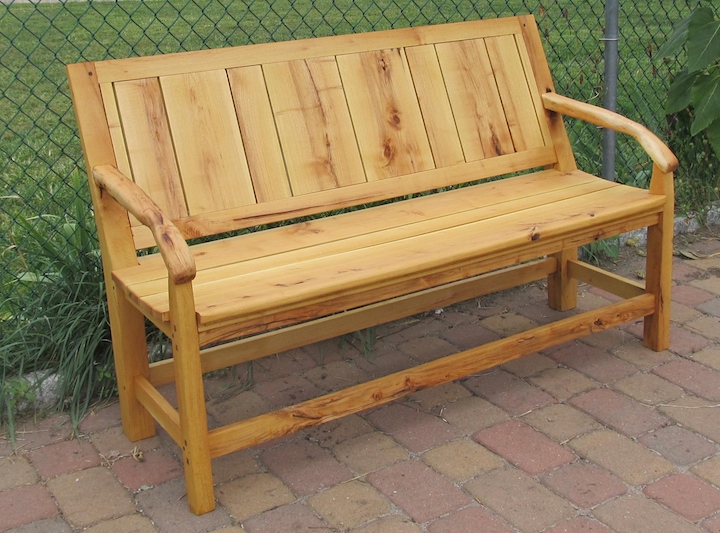

-
Newsletter for July 2016
Check out our July 2016 newsletter!

-
Nyack Seed Exchange at the Nyack Library
The Nyack Library will host the Nyack Seed Exchange every Saturday from 10 AM to 2 PM.

-
Joan Gussow at the Nyack Library
The Nyack Library will host the Seed Starting Slam with Special Guest Joan Gussow on Saturday March 12 from 2:30 to 4:30.

-
Past Newsletters
Each year a garden committee creates a newsletter. Here are newsletters from past years:
- Newsletter September 2011
- Newsletter August 2012
- Newsletter August 2013
- Newsletter October 2014
- Newsletter 2015
- Newsletter July 2016

-
Garden Contest 2015
The winners of today’s annual contest at the Nyack Community Garden are as follows:
Most Creative
- 1st place: Plot 24, Marie *
- 2nd place: Plot 37/38, Jill Remaly, Colleen O’Connell & Shane Grady
- 3rd place: Plot 19, Duncan Bell
Best Flower and/or Vegetable
- 1st place: Plot #42, Lynda Grant
- 2nd place: Plot #23, T. Robin Brown
- 3rd place: Plot #45 Susan Beckwith
Best Maintained
- 1st place: Plot #36, Jayne Stuecklen
- 2nd place: Plot #26, Kim Knight
- 3rd place: Plot #21, Umberto Fava
Best Overall
- Plot #3, Barbara Berasi-Rosen
Best Cluster
- Cluster #3
Well done!

-
Garden closes
The garden will close on November 1 2015. All plots must be cleared and clean and all vines must be removed from the plot’s fence by the end of the day. If you haven’t cleared your plot then you won’t be given a plot next year.

-
Garden Opens
The garden will open on Sunday March 29 2015.
Many vegetables do well in the spring. They will not grow as quickly as in the summer months but you should be able to get good germination because of the moister soil.
You can plant transplants or sow seed for arugula, lettuce, members of the cabbage family (cabbage, broccoli, cauliflower, and kale), mache, spinach, carrots, beets, onions, or peas. There are also many kinds of so-called Asian greens that do well in cooler weather.
Here’s a Zone 7 planting calendar.
This would also be a good time to plant a cover crop if you are so inclined.

-
Planting Deadline
Your garden must be fully planted by May 31. If you have not fully planted your garden by this day then your plot will be given to someone on the waiting list. In the past some gardeners have put very little effort into their gardens but this is no longer acceptable with such a high demand for garden plots.

-
Good Sources for Plants and Seeds
Seed Savers
This organization has been in existence for some 35 years, they’re dedicated to preserving heirloom varieties of fruit and vegetables. Extensive collection. They sell both plants and seeds. Good source for just about any vegetable, including some nice potato varieties and many garlics, lettuces …
Johnny’s Seeds
Seeds, plants, and many tools too, from Maine. You can get Bio360 Biodegradable Mulch here. Excellent source of information about growing in the North East, both varieties and practices. Definitely check this out if you want to order online.
Kitchen Garden Seeds
Small but very carefully selected catalog of seeds, both flowers and vegetables. They are based in Connecticut so their varieties work well in our weather.
Cross Country Nurseries
According to them this is the World’s largest selection of chile and sweet pepper plants. Tomatoes too! Easy to believe. Amazing selection of peppers, every variety and species you’ve ever heard of, or haven’t heard of. Datil, chiltepin, anchos, habaneros, Scotch Bonnet, even the Carolina Reaper, world’s hottest pepper!
They also have tomatilloes and eggplants. In New Jersey.
Hudson Valley Seed Library
From our own valley, a source for heirloom and open-pollinated garden seeds that should do well in our garden. They also have a very good blog.

-
Garden Contest 2014
Most Creative
- Plot 44, Robert Mauriello
- Plot 22, Jo Robbins/Barrie Peterson
- Plot 15, Marie/Tony Dilluvio
Best Flower and/or Vegetable
- Plot 9A, Jayne Stuecklen
- Plot 42, Lynda Grant
- Plot 34A, Mari *
Best Maintained
- Plot 2, Luis Febo
- Plot 25, K. N. Vivekanandan (Vivi)
- Plot 29, Richard Matic
Best Overall
- Plot 38, Shane Grady/Colleen O’Connell
Best Cluster
- Cluster 5 - plots 34-40
Well done!

-
Our garden soil
One thing a gardener is going to be curious about is what’s in their soil, particularly the urban gardener. I took soil samples from my plot and sent them off to the Cornell Nutrient Analysis Lab for testing where they performed their #2020 test (Soil Acid Package or Soil Total Elemental Analysis). This test measures the levels of some acid-soluble elements in the soil, including various metals. Here’s what they found, where the results are expressed in mg/Kg. These values are equivalent to parts per million (ppm).
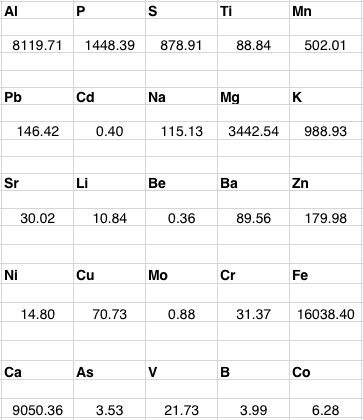
Amongst the elements listed there you have lead (Pb), arsenic (As), and cadmium (Cd), all potentially toxic. Are our levels high? Here’s a table that the lab supplied that shows some recommended maximum levels (our soil type is silt to clay):

Bottom line, we’re under the recommended maximum levels for arsenic, cadmium, copper, nickel, zinc, and arsenic, but slightly above what Cornell would like to see for lead (120 recommended, 146.42 actual). Is this a problem? You’ll find different opinions on this online but here’s a quote from Lead in the Home Garden and Urban Soil Environment (University of Minnesota):
Since plants do not take up large quantities of soil lead, the lead levels in soil considered safe for plants will be much higher than soil lead levels where eating of soil is a concern. Generally, it has been considered safe to use garden produce grown in soils with total lead levels less than 300 ppm. The risk of lead poisoning through the food chain increases as the soil lead level rises above this concentration. Even at soil levels above 300 ppm, most of the risk is from lead contaminated soil or dust deposits on the plants rather than from uptake of lead by the plant.
Wash or peel your produce, never eat the soil itself, and there’s no risk from this level of soil lead, that’s my interpretation.
If you do more research on this remember these are the total or acid-soluble levels. Many of the elements in the soil, like iron (Fe) and aluminum (Al), are present in multiple forms or salts. Most of these forms are insoluble when the soil pH is neutral, 6 to 8, and these insoluble forms are not taken up by the plants and do not affect the plants (see Behaviour of Metals in Soil for some science on this).
See More on our garden soil for the test results on our soil’s fertility.
Brian O

-
And more on our garden soil
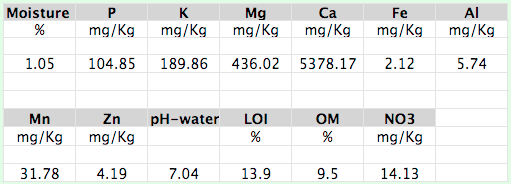
The second test performed by Cornell Nutrient Analysis Lab was their #1030 Soil Fertility Test. The results, above, are expressed in mg/Kg, equivalent to parts per million (ppm). The table below shows recommended ranges for some of these nutrients in farm or garden soil.
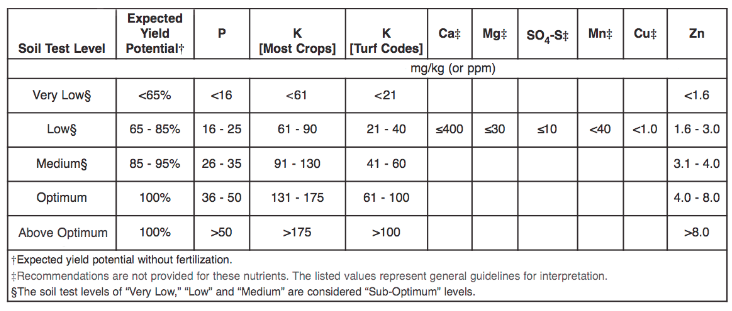
The previous article on soil tests mentioned some high total, metal levels, like those for iron (Fe) and aluminum (Al). But these metals only harm your plants if the soil is acid, which will dissolve the metals and make them available to the plants. You can see at the top that the soil’s pH is 7.04, nearly neutral, neither acid nor alkaline. So we’re in good shape there, the plants will do fine with the Fe and Al levels in our soil since most of the iron and aluminum is insoluble.
On the right you can see that the phosphorus (P) and potassium (K) levels in the soil are high, a bit above the optimum, in fact. This means that you do not need to fertilize in any way that will add P in particular, we’ve got enough already.
We also have plenty of the trace, soluble, minerals magnesium (Mg), calcium (Ca), iron (Fe), aluminum (Al), and zinc (Zn). The only mineral that’s on the low side is manganese (Mn) but even then it seems that you’d only try to add manganese to your soil if it’s less than 20 ppm and we have about 32. Remember that all living things need these minerals, they just don’t want too much of them.
Then we come to loss on ignition (LOI) and organic matter (OM). The levels are very good, around 10%, well above what some would consider the minimum amount of organic matter, which is 2%. Mind you though, this soil is taken from a plot that gets covered with hay every year. I even take my weeds (and my neighbors’ weeds!) and layer them underneath the hay where they decompose quickly. There’s a name for this, it’s called strip mulching. Between the hay and the weeds I’m adding a lot of organic matter to this soil, your plot probably is different if you’re not adding organic matter to it.
Finally we get the soil nitrate level (NO3), about 14 ppm. One way agronomists talk about soil nitrate is to refer to specific plants and their nitrate requirements. For example, if you grow sweet corn you want plenty of nitrogen, at least 25 ppm of nitrate. So to grow the best possible corn you’d find a way to add nitrogen to your plot, by adding manure or blood meal, or by growing a cover crop and tilling it in. Tomatoes, peppers, and squash are similar in their nitrate needs, ideally they get nitrate in the range of 25 to 50 ppm. Of course these plants grow and make great vegetables with less than 25 ppm nitrate but if you want the best possible outcome you’d add nitrogen in some form.
If you do add some form of nitrogen follow the instructions carefully! Over-fertilizing with N will give you big plants with lots of foliage and not much else. Great for cabbage, not so good for tomatoes.
Here’s a nice PDF on soil testing, if you’re interested in reading more: Understanding the Numbers in Your Soil Test Report.
Brian O

-
Garden Contest 2013
Best Vegetable
- Lauren Waldrop, 29
- Duncan Bell, 19
- John Dunnigan, 16
Best Flower and Vegetable
- Luis Febo, 2
- Lynda Grant, 42
- Jill Remaly & Olga Aguayo, 37
Best Maintained
- Vivi Vivikanadan, 25
- Zsolt Takacs, 7
- Brian Osborne, 10
Best Overall
- Jo Robbins & Barrie Petersen, 22
Well done!

-
Enjoy summer and plant for fall
Very nice article at the Hudson Valley Seed Library called Enjoying Summer, Planning for Fall. It talks about what you can plant now and for the next couple of months that will last through fall.

-
Cover crops
Planting a cover crop is a quick and easy way to put organic matter and nitrogen back into your soil. The cover crop will also compete with and suppress weeds. List of the common cover crops

-
Zone 7 Planting Calendar
Nyack is considered to be in USDA Hardiness Zone 7a (NY State hardiness zone map). Here’s a chart showing when to plant in zone 7:
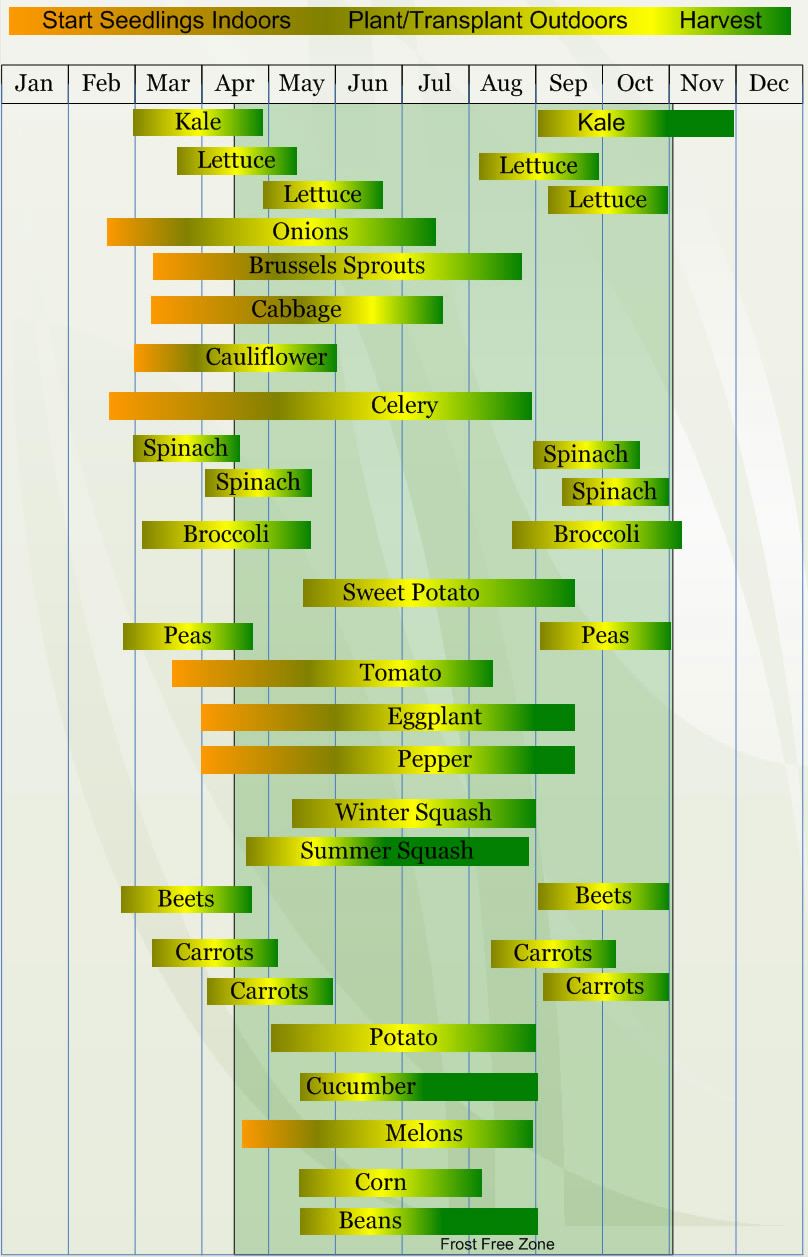

-
Garden Contest 2012
Best Vegetable
- Barbara Puff, 40
- Kimberly Knight and James Smith, 26
- Brian Osborne, 10
Best Flower and Vegetable
- John Strynkowski and Mark Socol, 36
- Joseph and Melissa Ondrek, 19
- Lauren Waldrop, 29
Best Maintained
- Betty Berlingeri, 46
- Pauline Heckstall, 14
- S. Johnson and J. Ross, 33B
Best Overall
- K.N. Kivekanandan, 25
Judges
- Eileen Bradford
- Mary Lukens
- Patty Aagaard
Well done!

-
What Tomato Disease is this?
A tomato disease hit our garden hard starting in the damp month of August. You’d hear talk of “blight” if you conversed with other gardeners but is it really the same disease that killed our tomatoes in July of 2009? That disease struck farms and gardens throughout New York and was Phytophthora infestans, or late blight, the same fungus that was responsible for the Irish potato famine. This disease is clearly not the same. For one it does not affect the fruit, whereas blight does. In addition its lesions have a different shape and color from late blight symptons (see tomato blight for pictures). Finally farmers and gardeners and scientists are not talking about blight this year in Rockland county, and it’s unlikely that there would be a late blight infestation that’s only affecting our garden given how devastating the blight was to all the local farms in 2009.
I’ve looked at various Web sites and concluded that it might be Gray Leaf Spot, or Stemphylium. It could also be Septoria Leaf Spot. I’m thinking this because of the affected tissues, leaves only (not fruit), and the appearance of the lesions. Take a look at the pictures below, these show how the disease progresses:
- Small, dry brown or gray-brown spots appear first on the underside of the leaves
- Dry yellow or brown spots appear on the top of the leaves once the infection is established underneath
- Sections of the leaf turn brown and die
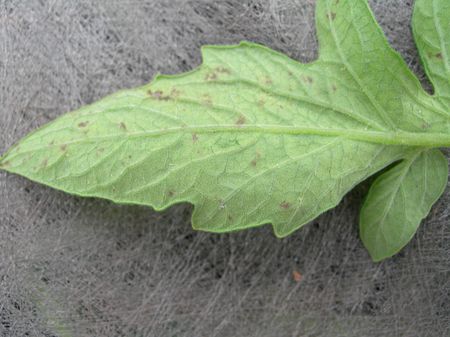
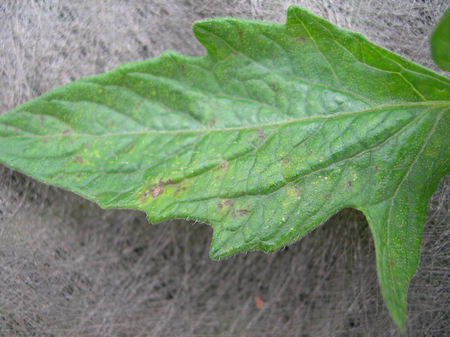
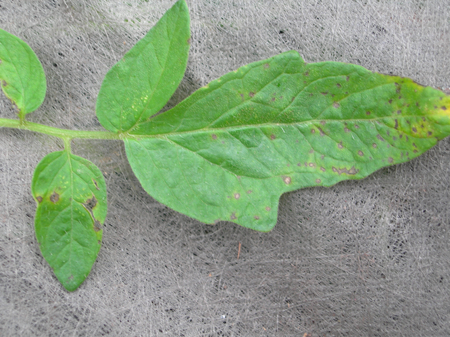
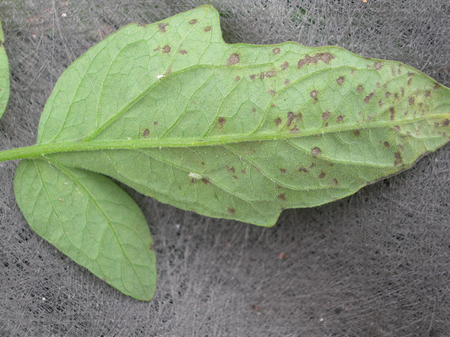
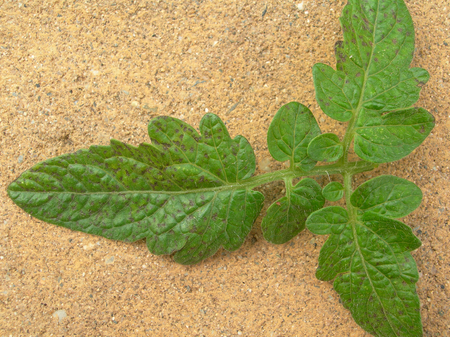
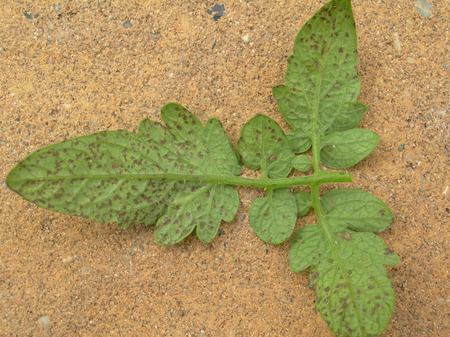
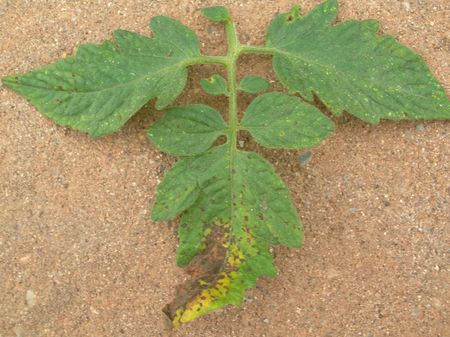
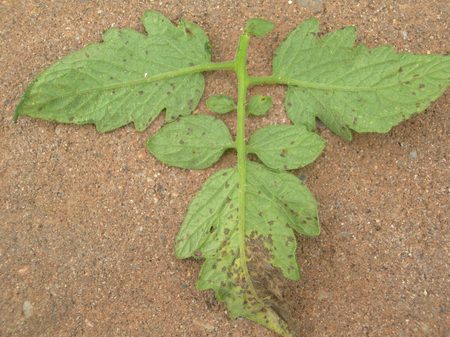
Here’s some common-sense advice:
- Keep your tomatoes dry by watering them at ground level since the fungus flourishes on wet leaves
- The disease starts at the bottom of the plant so check the undersides of those lower leaves
- Remove any leaf that has the characteristic gray or brown spots
- Take any and all infected tissue out of the garden
A useful Web site is the Vegetable MD Online, from Cornell.
Brian O

-
Mulch
Don’t be the gardener who is cursing in July while hoeing or hand-weeding overgrown weeds in the blazing sun. There is an easier way, it’s mulch. When you mulch you weed much less, you water less, and your soil is moister in mid-summer. Trust us, you want to mulch and your plants will thank you too.
Many gardeners in this garden use plastic mulch, which comes in sheets that you roll out and pin down with metal or plastic pegs. The problem with plastic sheets is that it does not decompose, so your soil gets no benefit. Then you’ve got the plastic waste itself every year, that’s not good.
You want to put the plastic or Bio360 down early in the season, for 2 reasons. One, this prevents the weeds from getting started. The classic mistake is to let the weeds get a foothold, it’s impressive how quickly they grow, starting mid-June. Two, your soil is going to heat up faster with this mulch in place and most plants that thrive in summer, like tomatoes, love warm soil.
The other popular choice is straw or hay, which you can buy in bales from Home Depot or Loew’s, or any garden center. The key to using hay is to put it down thickly. If you can see the soil through the hay then the weeds will grow. Put a layer down that’s at least 6” deep. Over the season the hay slowly decomposes, so don’t be stingy! Expect to use at least 2 bales of hay or straw for a full plot, over the entire season.
Bear in mind that straw is an insulator so if you lay it down on cool soil that soil is going to heat up more slowly. Wait until mid-June or so to put down your straw mulch.
The third choice is a biodegradable mulch, like Bio360 Biodegradable Mulch. The material comes in rolls like plastic mulch but decomposes slowly. It’s black and absorbs sunlight, heating up the soil, which the heat-loving plants like tomatoes and peppers are going to like.
Here’s a good article on mulch from Rodale.
Brian O

